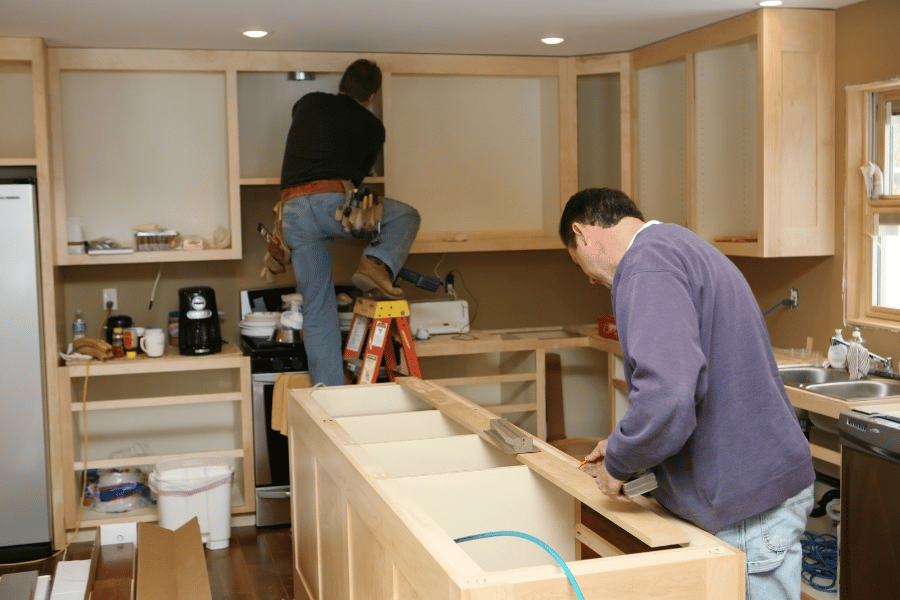Remodeling your home is an exciting time, full of possibilities to improve your living space. However, if you have a Heating, Ventilation, and Air Conditioning (HVAC) system in place, it’s crucial to take the right precautions to protect it during construction.
Dust, debris, and fluctuating temperatures can significantly impact your HVAC system, potentially leading to expensive repairs or reduced efficiency. Here are some tips to help you safeguard your system while ensuring the remodeling process goes smoothly.

1. Turn Off the HVAC System During Demolition
One of the biggest risks during a remodel is the amount of dust and debris that gets stirred up. If your HVAC system is running, the air ducts can quickly become clogged with dust, causing blockages and putting undue stress on the system.
Fine particles can also make their way into the sensitive components of your furnace, air handler, or air conditioner, leading to malfunctions.
Whenever possible, turn off your HVAC system during demolition work or when there’s a lot of dust in the air. If you need the system running for ventilation or comfort, consider alternative options like portable fans or temporary air conditioning units.
2. Seal Off Vents and Ductwork
Even if you turn off your HVAC system, dust and debris can still find their way into the ducts. It’s a good idea to completely seal off the air vents and registers in rooms where work is being done. You can use plastic sheeting and painter’s tape to cover the openings, preventing dust from entering.
For extra protection, you can also temporarily block the ducts with filters or foam inserts. Just make sure to remove these once the renovation is complete to restore proper airflow.
3. Create a Dust Containment Plan
Dust is inevitable during a remodel, but controlling where it goes is possible. Create a dust containment plan to minimize the spread of airborne particles. This can include using plastic sheets to seal off the work areas, covering floors, and installing zippered plastic doorways to keep dust contained to a specific area.
When possible, use dust barriers to separate rooms where the HVAC system is running from the areas being worked on. If your renovation involves cutting or sanding, consider using tools with dust collection features to minimize airborne debris.
4. Clean or Change Filters Regularly
During a remodel, your HVAC filters will become clogged with dust much faster than usual. Dirty filters reduce the efficiency of your system and can lead to poor indoor air quality. To prevent this, check your filters more frequently during construction and replace them as needed.
In some cases, upgrading to a higher-efficiency filter can offer added protection against fine particles. However, make sure that your system is designed to handle higher-efficiency filters, as they can sometimes restrict airflow.
5. Schedule Professional Duct Cleaning Post-Remodel
No matter how careful you are, dust will inevitably find its way into your ductwork during a remodel. After the work is complete, it’s a good idea to schedule a professional duct cleaning to remove any lingering debris. This not only helps your HVAC system run efficiently but also improves the overall air quality in your home.
Duct cleaning will remove dust, dirt, and other contaminants that may have settled during the construction process, preventing potential issues like clogs or poor indoor air quality down the road.
6. Install Temporary Barriers to Protect Equipment
If your HVAC system is located in an area where renovations are taking place, it may be at risk of physical damage. For example, if your air conditioner’s outdoor unit or furnace is near the construction zone, install temporary barriers or covers to protect it from falling debris or accidental contact with tools and materials.
Make sure that the barriers still allow for proper ventilation and airflow. Blocking off too much air can cause the system to overheat, leading to potential damage.
7. Plan for Temperature Fluctuations
If the renovation requires parts of your home to be open to the elements, such as replacing windows or doors, be prepared for potential temperature fluctuations. These sudden changes can put extra strain on your HVAC system as it works harder to maintain a consistent indoor temperature.
Consider turning off the system during these phases of the remodel to reduce stress on the unit. If the construction will leave your home exposed for an extended period, you may want to invest in a temporary heating or cooling solution to maintain comfort without overburdening your HVAC system.
8. Consult with an HVAC Professional
Finally, it’s always a good idea to consult with an HVAC professional before and after a remodel. They can help you assess potential risks to your system and offer personalized recommendations for protecting your equipment.
After the renovation, they can also perform a thorough inspection to ensure everything is functioning correctly and that your system hasn’t been damaged.
By following these precautions, you can protect your HVAC system from unnecessary wear and tear during your home renovation. A little planning goes a long way in preserving the efficiency and longevity of your system, ensuring that it continues to keep your home comfortable for years to come.
If you are experiencing a problem with your air conditioning or heating call us at 512-336-1431 to schedule an appointment. We’ll be glad to come out and take a look at the issue.
1431-183 A/C & Heating proudly serves Round Rock, Georgetown, Cedar Park, Pflugerville, Leander, Liberty Hill, and North Austin.
